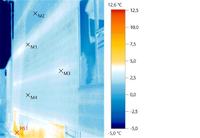On a normal winter day, what yield will 3850Wp amorphous panels placed vertically on a mostly shaded building wall give? I know that amorphous panels are more pros and cons.
Are stains and dirt visible on the vertical panels?
I am asking for an objective assessment of the economic sense of installing amorphous panels on the vertical western wall.
For three years, the main source of heating a house with the annual demand for CO 30MWh has been PC P / W, and the peak source is the DS 25kW boiler. Last winter has slightly verified the possibilities of my PV system with PC P / W appetite in an expensive tariff, significantly increasing the operating costs, and since I had some wood and coal residues, I was cleaning them up in the DS boiler This year, I was supposed to insulate only two niches by the balconies (thermal bridges at the windows), but the thermal imaging of the side wall suggests its insulation.
This year, I was supposed to insulate only two niches by the balconies (thermal bridges at the windows), but the thermal imaging of the side wall suggests its insulation.

With my current heating costs, expenses related to insulation will never pay off, I am more interested in the comfort effect (no chilled ceilings, no need to support the PC with the DS boiler) and finishing than the electric energy gain.
Can the GS-50 amorphous panels be mounted vertically at all - taking into account their performance and technical considerations?
Is there any sense in this mounting on a wall facing west and obscured by a neighboring house 6 meters away?
I have a tall and moderately energy-consuming house, its side wall is about 8.6 meters wide, 9 meters high, and the highest point is 11.5 meters high.
I am thinking of insulating this wall: the cost with the material will come out about 10-11 thousand. .
I wonder if it is worth putting the insulation on my own, seal it up with mortar, paint it with paint and put amorphous panels on it. I will do all / most of the work myself (installation of double-threaded screws, mounting strips, sticking polystyrene on PU foam, placing an adhesive layer on polystyrene + some ground).
Costs:
the highest part made by the company is about 2 - 3 thousand. PLN and depends on the area
cost of the fastening system 3.6 thousand PLN
inverter and cables 2.3 thousand PLN
77 panels 3,000 PLN + transport
polystyrene foam mortar approx. 3 thousand. PLN
in total 14-15 thousand PLN + transport of panels and some fun. [/ align]
Are stains and dirt visible on the vertical panels?
I am asking for an objective assessment of the economic sense of installing amorphous panels on the vertical western wall.
For three years, the main source of heating a house with the annual demand for CO 30MWh has been PC P / W, and the peak source is the DS 25kW boiler. Last winter has slightly verified the possibilities of my PV system with PC P / W appetite in an expensive tariff, significantly increasing the operating costs, and since I had some wood and coal residues, I was cleaning them up in the DS boiler

With my current heating costs, expenses related to insulation will never pay off, I am more interested in the comfort effect (no chilled ceilings, no need to support the PC with the DS boiler) and finishing than the electric energy gain.
Can the GS-50 amorphous panels be mounted vertically at all - taking into account their performance and technical considerations?
Is there any sense in this mounting on a wall facing west and obscured by a neighboring house 6 meters away?
I have a tall and moderately energy-consuming house, its side wall is about 8.6 meters wide, 9 meters high, and the highest point is 11.5 meters high.
I am thinking of insulating this wall: the cost with the material will come out about 10-11 thousand. .
I wonder if it is worth putting the insulation on my own, seal it up with mortar, paint it with paint and put amorphous panels on it. I will do all / most of the work myself (installation of double-threaded screws, mounting strips, sticking polystyrene on PU foam, placing an adhesive layer on polystyrene + some ground).
Costs:
the highest part made by the company is about 2 - 3 thousand. PLN and depends on the area
cost of the fastening system 3.6 thousand PLN
inverter and cables 2.3 thousand PLN
77 panels 3,000 PLN + transport
polystyrene foam mortar approx. 3 thousand. PLN
in total 14-15 thousand PLN + transport of panels and some fun. [/ align]


